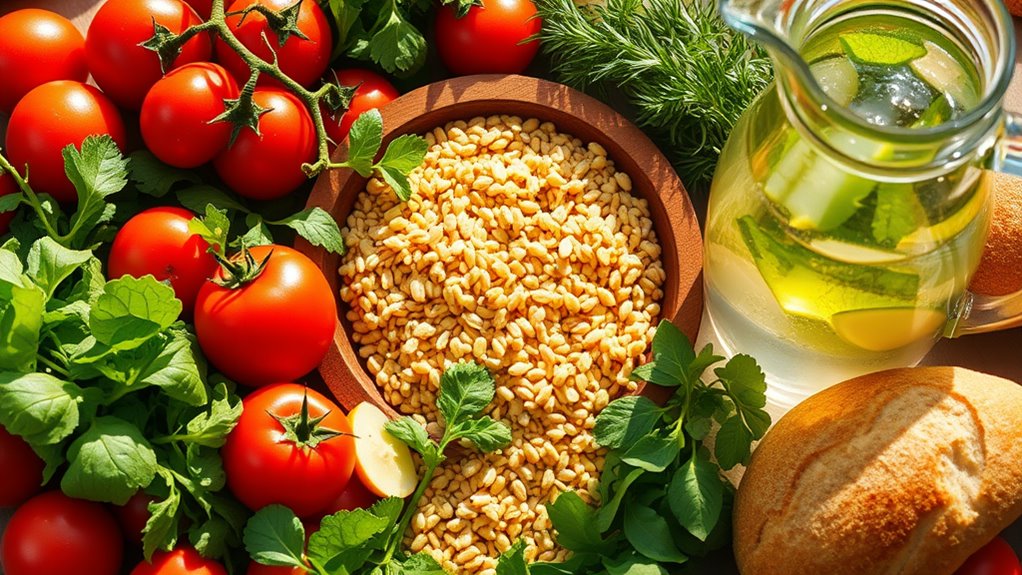Your Guide to Getting the Most From Everyday Foods
To get the most from everyday foods, focus on their nutritional value. Include a variety of fruits, veggies, whole grains, and lean proteins in your meals. Pay attention to portion sizes to maintain a healthy balance. Combine foods like iron-rich spinach with vitamin C for better absorption. Don’t forget proper food storage to prevent waste. By following these tips, you’ll enhance your health and wellness. There’s much more you can explore on this topic.
Key Takeaways
- Focus on incorporating a variety of nutrient-dense foods, such as fruits, vegetables, whole grains, and lean proteins, into your meals.
- Pay attention to portion sizes to maintain a balanced diet and avoid overeating, using the FDA’s updated serving size guidelines.
- Pair foods strategically, like combining iron-rich foods with vitamin C, to enhance nutrient absorption and maximize health benefits.
- Plan meals ahead of time to utilize seasonal produce and grocery discounts, while also minimizing waste through batch cooking.
- Store foods properly to prevent spoilage and foodborne illnesses, ensuring they remain safe and nutritious for consumption.
Understanding Nutritional Value of Common Foods
When you think about your diet, understanding the nutritional value of everyday foods is crucial for making healthier choices. Nutritional hacks can help you maximize benefits from what you eat. For instance, incorporating oily fish into your meals boosts omega-3 fatty acids, supporting heart health. Eggs are a powerhouse of vitamins and antioxidants, while avocados provide healthy fats and important nutrients like vitamin E. Additionally, many of these nutrient-dense foods, such as leafy greens, can help reduce the risk of chronic diseases. Don’t overlook leafy greens like kale, packed with vitamins A, C, and K, which offer protective health benefits. Even humble potatoes are nutrient-dense and easy to prepare, making them a great source of potassium.
Building Balanced Meals for Optimal Health
When building balanced meals, it’s vital to include essential food groups like fruits, vegetables, whole grains, lean proteins, and healthy fats. Incorporating a variety of food groups ensures that you receive the necessary essential nutrients for overall health. Additionally, aiming for a balanced plate helps to provide all the nutrients your body needs for optimal functioning. You should also pay attention to portion sizes to guarantee you’re getting the right nutrients without overeating.
Essential Food Groups
Building a balanced diet isn’t just about counting calories; it involves understanding the fundamental food groups that fuel your body.
Start with macronutrients: proteins, carbohydrates, and fats. They provide energy and help build and repair tissues. Include whole grains like oats and brown rice for sustained energy, as they are excellent sources of carbohydrates that provide essential nutrients. Choosing nutritious foods is crucial for optimal health and longevity.
Don’t forget micronutrients from fruits and vegetables; aim for at least five servings daily for crucial vitamins and antioxidants.
Hydration is also key—drink plenty of water to help regulate your body and flush out toxins.
Finally, variety matters; consuming a diverse range of foods guarantees you get all necessary nutrients.
This balanced approach helps maintain peak health and prevents deficiencies, setting you up for success in your wellness journey.
Portion Size Importance
Understanding portion sizes is crucial for creating balanced meals that support optimal health. Proper portions help you manage weight and reduce the risk of chronic diseases. By being mindful of how much you consume, you’ll guarantee a balanced intake of nutrients. The FDA has updated serving sizes to better reflect typical consumption patterns, which can help you make more informed choices when planning your meals. Achieving nutrient balance is essential for sustaining long-term health and wellness.
| Portion Size Type | Example |
|---|---|
| Protein | 3 ounces (about the size of a deck of cards) |
| Grains | 1 cup cooked (about the size of a fist) |
| Vegetables | 2 cups raw (about the size of two fists) |
Using smaller plates, measuring food, and planning meals can aid in portion control. When dining out, consider sharing meals or choosing smaller options. Remember, awareness of portion sizes is key for ideal health and well-being.
Strategies for Effective Meal Planning
Effective meal planning can transform your week, making it easier to enjoy nutritious meals while saving time and money.
To get started, consider these strategies:
-
Set a routine: Pick a specific day to plan your meals and stick to it.
-
Utilize social media: Discover easy recipes that inspire you and fit your tastes. Including whole foods in your meal planning can enhance your diet and promote natural detoxification.
-
Plan around deals: Create menus based on what’s discounted at your grocery store to cut costs.
-
Maximize leftovers: Turn last night’s dinner into a new meal to reduce waste. Additionally, batch cooking allows you to prepare larger quantities of dishes, ensuring you have healthy meals readily available throughout the week.
Mastering Grocery Shopping for Nutrient Density
When you’re grocery shopping, focus on choosing whole foods that pack a nutritional punch.
Reading nutrition labels helps you identify the best options, while selecting seasonal produce guarantees freshness and flavor.
Choosing Whole Foods
How can you make the most of your grocery shopping to guarantee you’re choosing the most nutrient-dense foods? Start by focusing on whole foods that pack a nutritional punch.
Here are some key categories to prioritize:
-
Vegetables: Load up on dark leafy greens, cruciferous veggies, and root vegetables.
-
Fruits: Pick whole fruits like apples and berries for their fiber and antioxidants.
-
Whole Grains: Opt for brown rice, quinoa, and whole-grain bread.
-
Legumes: Incorporate beans and lentils for a boost of protein and fiber.
Reading Nutrition Labels
Mastering the art of reading nutrition labels can greatly enhance your grocery shopping experience, ensuring you select foods that truly nourish your body. Start by checking the serving size and calories per serving, as these inform you about portion control. Focus on the nutrient profile; seek foods high in dietary fiber, vitamins, and minerals while limiting unhealthy fats, sodium, and added sugars.
| Nutrient Type | Recommendation |
|---|---|
| Saturated Fats | Limit to < 10% DV |
| Added Sugars | Limit to < 10% DV |
| Dietary Fiber | Aim for 25g+ daily |
| Vitamin D | 20mcg+ daily |
| Calcium | 1,000mg+ daily |
With practice, you’ll make informed choices that align with your health goals.
Seasonal Produce Selection
Understanding nutrition labels is a great first step toward healthier grocery shopping, but selecting seasonal produce can take your choices to the next level.
By opting for in-season fruits and vegetables, you not only maximize nutrition but also support local farmers.
Here are some tips for selecting the best seasonal produce:
-
Vibrant Colors: Choose bright, colorful items; dull colors may mean over-ripeness.
-
Firmness: Gently squeeze produce; soft spots often indicate spoilage.
-
Smell: Fresh items should have a pleasant aroma; avoid any with off-putting smells.
-
Skin Inspection: Look for blemishes or mold, which can signal poor quality.
Enhancing Nutrient Intake Through Smart Combinations
When you combine certain foods wisely, you can greatly enhance your nutrient intake and overall health. Here are some smart combinations to evaluate:
| Food Combination | Benefit | Nutrients Enhanced |
|---|---|---|
| Iron + Vitamin C | Boosts iron absorption | Non-heme iron absorption |
| Tomatoes + Olive Oil | Increases antioxidant benefits | Lycopene bioavailability |
| Spinach + Avocado | Improves vitamin A absorption | Vitamin A from spinach |
Incorporating these combinations into your meals can lead to better nutrient absorption and overall wellness. Experiment with these pairings to maximize the health benefits your food can offer!
Fostering Digestive Health With the Right Foods
To maintain ideal digestive health, you need to pay attention to the foods you eat. Focus on incorporating a variety of fiber-rich and fermented foods into your diet. Here are some key considerations:
-
Choose whole grains and leafy greens for essential fiber, supporting gut bacteria and immune function.
-
Include fermented options like yogurt and kimchi, which enhance digestion with probiotics.
-
Opt for lean proteins such as poultry and fish to minimize gastrointestinal stress.
-
Incorporate fruits like bananas and berries, which provide fiber and antioxidants that aid digestion.
Gradually increase your fiber intake to avoid discomfort, and enjoy a mix of these foods to promote overall digestive well-being.
Exploring Nutrient-Dense Food Groups
Maintaining digestive health through the right foods sets the stage for exploring nutrient-dense food groups that can further enhance your well-being.
Fruits and vegetables are packed with essential vitamins and minerals, while whole grains like brown rice and quinoa provide crucial fiber and B vitamins.
Dairy options such as low-fat milk and yogurt contribute calcium and probiotics, promoting gut health.
Lean proteins, including legumes and fatty fish like salmon, offer necessary nutrients and healthy fats.
Incorporating these foods into your daily meals—think berry-packed breakfasts, hearty salads for lunch, and omega-3-rich dinners—will help you optimize your nutrient intake.
Best Practices for Food Storage and Preparation
Understanding the best practices for food storage and preparation is essential for keeping your meals safe and nutritious. By following these guidelines, you’ll minimize the risk of foodborne illnesses and maintain quality:
-
Store high-risk foods at 5 °C (41 °F) or below to prevent bacterial growth.
-
Keep raw foods below cooked foods in the fridge to avoid cross-contamination.
-
Use clean, non-toxic containers with tight-fitting lids for storage.
-
Always check expiration dates to avoid consuming expired items.
Additionally, allow hot foods to cool before refrigerating and use shallow containers for faster cooling.
Frequently Asked Questions
How Can I Identify Nutrient-Dense Foods While Shopping?
To identify nutrient-dense foods while shopping, check labels for high vitamins and minerals, compare calorie counts, and choose whole grains, fresh produce, and low-fat dairy. Look for healthy fats like nuts and seeds, too.
What Are the Best Cooking Methods for Preserving Nutrients?
Did you know that cooking can cause up to 50% nutrient loss? To preserve nutrients, try steaming, poaching, or quick roasting. These methods help retain vitamins and enhance flavors, keeping your meals both nutritious and delicious.
How Do I Know if I Need Dietary Supplements?
To determine if you need dietary supplements, assess your diet for nutrient gaps, consider any specific health concerns, and consult your healthcare provider. They can guide you based on your individual nutritional needs and lifestyle.
What Are the Signs of a Healthy Gut Microbiome?
Think of your gut as a thriving garden; signs of a healthy microbiome include regular digestion, minimal bloating, consistent energy, improved mood, and a robust immune system. If you notice these, you’re likely on the right track.
How Can I Safely Store Leftovers to Maintain Freshness?
To safely store leftovers and maintain freshness, refrigerate them in clean, leak-proof containers within two hours. Consume within 2-3 days, and freeze for longer storage, ensuring you label each container with the date.
References
- https://www.ars.usda.gov/is/np/NutritiveValueofFoods/NutritiveValueofFoods.pdf
- https://manuu.edu.in/dde/sites/default/files/DDE/DDE-SelfLearnmaterial/BA-6thSemester/Englishba6th28may24.pdf
- https://www.fda.gov/food/nutrition-facts-label/daily-value-nutrition-and-supplement-facts-labels
- https://www.aupress.ca/app/uploads/OER-202302_Chamberlain_Dubberlboer_2023-Read-Think-Write.pdf
- https://www.canada.ca/content/dam/hc-sc/migration/hc-sc/fn-an/alt_formats/pdf/nutrition/fiche-nutri-data/nvscf-vnqau-eng.pdf
- https://www.healthline.com/nutrition/11-most-nutrient-dense-foods-on-the-planet
- https://www.coursehero.com/tutors-problems/Health-Science/58282791-Instructions-Before-you-begin-this-assignment-be-sure-to-read-the/
- https://www.coursehero.com/file/235492734/Analyzing-Nutrition-Insights-from-a-Personal-3-Day-Study/
- https://umccares.org/how-to-create-a-balanced-meal-plan-for-optimal-health/
- https://www.semrush.com/blog/blog-ideas/

